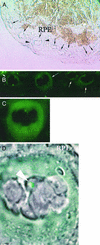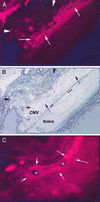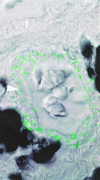Immunotherapy for choroidal neovascularization in a laser-induced mouse model simulating exudative (wet) macular degeneration
- PMID: 12589025
- PMCID: PMC151400
- DOI: 10.1073/pnas.0438014100
Immunotherapy for choroidal neovascularization in a laser-induced mouse model simulating exudative (wet) macular degeneration
Abstract
Age-related macular degeneration (AMD) is the leading cause of blindness after age 55 in the industrialized world. Severe loss of central vision frequently occurs with the exudative (wet) form of AMD, as a result of the formation of a pathological choroidal neovasculature (CNV) that damages the macular region of the retina. We tested the effect of an immunotherapy procedure, which had been shown to destroy the pathological neovasculature in solid tumors, on the formation of laser-induced CNV in a mouse model simulating exudative AMD in humans. The procedure involves administering an Icon molecule that binds with high affinity and specificity to tissue factor (TF), resulting in the activation of a potent cytolytic immune response against cells expressing TF. The Icon binds selectively to TF on the vascular endothelium of a CNV in the mouse and pig models and also on the CNV of patients with exudative AMD. Here we show that the Icon dramatically reduces the frequency of CNV formation in the mouse model. After laser treatment to induce CNV formation, the mice were injected either with an adenoviral vector encoding the Icon, resulting in synthesis of the Icon by vector-infected mouse cells, or with the Icon protein. The route of injection was i.v. or intraocular. The efficacy of the Icon in preventing formation of laser-induced CNV depends on binding selectively to the CNV. Because the Icon binds selectively to the CNV in exudative AMD as well as to laser-induced CNV, the Icon might also be efficacious for treating patients with exudative AMD.
Figures




Similar articles
-
Development of gene therapy for treatment of age-related macular degeneration.Acta Ophthalmol. 2014 Jul;92 Thesis3:1-38. doi: 10.1111/aos.12452. Acta Ophthalmol. 2014. PMID: 24953666
-
Effect of quercetin on formation of choroidal neovascularization (CNV) in age-related macular degeneration(AMD).Eye Sci. 2011 Mar;26(1):23-9. doi: 10.3969/j.issn.1000-4432.2011.01.006. Eye Sci. 2011. PMID: 21425492
-
Choroidal neovascularization in the Choroidal Neovascularization Prevention Trial. The Choroidal Neovascularization Prevention Trial Research Group.Ophthalmology. 1998 Aug;105(8):1364-72. doi: 10.1016/s0161-6420(98)98014-9. Ophthalmology. 1998. PMID: 9709744 Clinical Trial.
-
[Novel approach for management of age-related macular degeneration--antiangiogenic therapy and retinal regenerative therapy].Nippon Ganka Gakkai Zasshi. 2007 Mar;111(3):232-68; discussion 269. Nippon Ganka Gakkai Zasshi. 2007. PMID: 17402564 Review. Japanese.
-
Age-related macular degeneration: epidemiology and optimal treatment.Drugs Aging. 2002;19(2):101-33. doi: 10.2165/00002512-200219020-00003. Drugs Aging. 2002. PMID: 11950377 Review.
Cited by
-
Role of Adiponectin Peptide I (APNp1) in Age-Related Macular Degeneration.Biomolecules. 2022 Sep 3;12(9):1232. doi: 10.3390/biom12091232. Biomolecules. 2022. PMID: 36139070 Free PMC article.
-
Association between genetic variation of complement C3 and the susceptibility to advanced age-related macular degeneration: a meta-analysis.BMC Ophthalmol. 2018 Oct 23;18(1):274. doi: 10.1186/s12886-018-0945-5. BMC Ophthalmol. 2018. PMID: 30352574 Free PMC article.
-
Exosomes from retinal astrocytes contain antiangiogenic components that inhibit laser-induced choroidal neovascularization.J Biol Chem. 2013 Sep 27;288(39):28058-67. doi: 10.1074/jbc.M113.470765. Epub 2013 Aug 7. J Biol Chem. 2013. PMID: 23926109 Free PMC article.
-
Complement factor h is critical in the maintenance of retinal perfusion.Am J Pathol. 2009 Jul;175(1):412-21. doi: 10.2353/ajpath.2009.080927. Epub 2009 Jun 18. Am J Pathol. 2009. PMID: 19541934 Free PMC article.
-
Tissue factor pathway inhibitor: structure-function.Front Biosci (Landmark Ed). 2012 Jan 1;17(1):262-80. doi: 10.2741/3926. Front Biosci (Landmark Ed). 2012. PMID: 22201743 Free PMC article. Review.
References
Publication types
MeSH terms
Substances
LinkOut - more resources
Full Text Sources
Other Literature Sources
Medical
Miscellaneous

